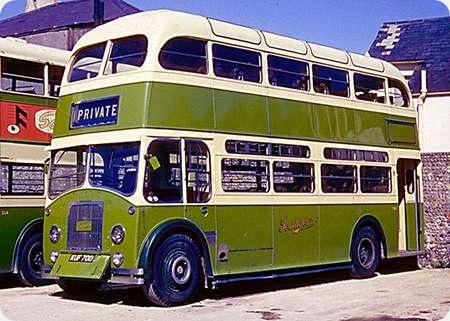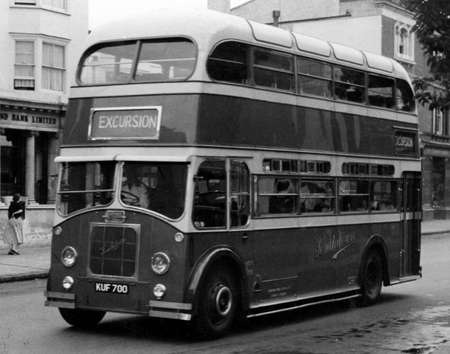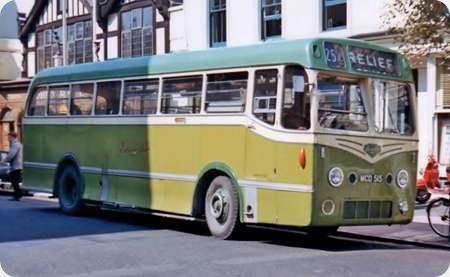
Copyright Cliff Essex – Flickr
Southdown Motor Services Ltd
1950
Leyland PD2/12
Northern Counties FCH28/16RD
In the post about Southdown’s Leyland Titan PD2 756 (MUF 456), Diesel Dave made mention of Southdown’s one-off 700 and Michael Hampton said he saw it in Bognor Depot’s Yard.
KUF 700 was Southdown’s 700, a 1950 Leyland Titan PD2/12 with Northern Counties FCH28/16RD bodywork and was intended to be the first of a fleet of such vehicles for use on express services from the South Coast to London.
It began work on the Eastbourne to London service, but proved totally unsuitable, suffering excessive body-roll and under-performance, being overweight and therefore under-powered. By 1952, it was relegated to private hire and bus work.
This photo was taken at Bognor Depot in 1959, with the bus still looking remarkably chipper and still possessing its coach seats, although with its roof lights painted over.
In this limbo situation, it somehow survived in service until 1966, when it was taken into Portslade works for conversion to a breakdown tender, but the work remained unfinished and the vehicle languished there for some six years, eventually being scrapped there in 1973. Sixteen years active life for a bus, which was somewhat of an embarrassment, could be considered quite an achievement, as it happens.
The lower front bears a definite resemblance to Southdown’s later Queen Mary’s and the body, as a whole, still has the overall look of NCME’s pre-war models, notably the Leicester AEC Renowns of 1939, a design not destined to last much longer.
Photograph and Copy contributed by Chris Hebbron
15/01/15 – 06:10

It is wonderful to see Chris’s colour photo of Southdown 700 as I only have a B/W photo which I bought in 1958 from the late Eric Surfleet of Lancing. This shows 700 on an excursion still in it’s original livery which had green window surrounds and the usual dark green lining on the horizontal beading also the corner bumpers on the front and rear,the bumpers are still on the front at least even after it’s repaint. The top deck coving panels were I believe always translucent and not clear glass. Sad to say despite living in the area at the time, and attending school in Hailsham which was on it’s route, I don’t recall seeing this fine vehicle.
Diesel Dave
15/01/15 – 09:31
Thanks to Chris for the great colour shot of 700, and Diesel Dave for it in it’s earlier more public life. As I said in the earlier posting, my usual sightings of it were c. 1960-62, and it was always in the Bognor yard. But it was always in a different position, so clearly saw some use. It does seem strange that East Yorkshire and Ribble operated a small fleet of such vehicles with (presumably) some success, while Southdown, usually effective in their plans, found they could not make 700 work on the coach work originally envisaged. A fleet of such vehicles on the 31 had to wait until the Queen Mary PD3s arrived, and they didn’t have coach seats!
Michael Hampton
15/01/15 – 10:32
What a wonderful photo – thanks Chris for posting it. As many readers will know, this vehicle has generated interested on the SCT61 website and it is good to see these two further views of this magnificent coach. When it was downgraded to bus duties, did it keep the luggage areas in the lower saloon? If so, a capacity of just 16 must have been a major factor in its demise. A similar fate befell the East Yorkshire and Ribble d/d coaches but at least they managed to get 20 and 22 seats respectively in their lower saloons.
Paul Haywood
15/01/15 – 11:21
Following Michael H’s comments, here’s a photo of a Leyland PD2 49-seat Ribble White Lady. There were 50 of them, in two batches, with bodies (5-bay) by Burlingham and 4-bay East Lancs ones. There seems an irony to put a lowbridge body on a so-called coach, but it did not seem to affect custom!. Ribble – //tinyurl.com/os4f47k
And here’s a photo of East Yorkshire’s Leyland PD2 with Roe normal height body. East Yorkshire – //www.sct61.org.uk/ey568
There was something very satisfying about double-deck coach design of this period, even conventional half-cab types. I recall the West Yorkshire version of a Bristol K6B Scarborough Express, way down the OBP page, the upper photo, not the lower abomination! SEE //tinyurl.com/ono24n2
Chris Hebbron
23/02/15 – 14:31
I remember 700 KUF 700 very well as a school boy in Bognor yard where I spent most of my after school time. Bob Mustchin the foreman in the garage took me under his wing and many a time I helped him shunt it around the yard when it been dumped from a private hire or bus relief working. This led to me buying one of the left luggage offices D689 HCD 449 which has been fantastically restored now by Bob Gray. The yard has a vivid memory for me with a flint stone boundary with access only through the bus station rear doors until the retail development created an entrance from Queeensway giving access directly into the yard and changing the in/out pattern for local services and coaches. I remember the transition from TD5’s TS7/8’s with PD2 1’s through to underfloor Leylands and the arrival of PD2/12’s to PD 3’s
Clifford Jones
13/03/15 – 07:12
I have posted my memories of this vehicle already however I would like to add that the B/W photo of it showing an excursion blind in taken in Bognor Regis High Street with 700 heading west as Lloyds bank is in the background. My family banked there with the International store visible to the right including trees in the foreground which were a feature in the High Street of that era. I have a photo of 700 solitarily languishing in the corner of Bognor yard against a corner of the flint wall overshadowing the Queensway development which would shortly see the demise of the wall. My memories of Southdown in Bognor my birth place are being prepared.
Clifford Jones
13/03/15 – 16:52
I, for one, will look forward to your jottings of Southdown in Bognor Regis, Clifford.
I lived in Pompey for 20 years, the Western boundary of Southdown. I travelled on its two most Westerly routes (I think), from Portsmouth to Warsash and Portsmouth to the somewhat mundane place name, Meon Hut!
Your mention of International Stores reminds me of all the other grocery stores of the time: Home & Colonial, Pearks, Maypole Dairies, David Greig and, of course, Sainsbury, before it became a supermarket. Other, later stores/supermarkets were MacFisheries (our first local supermarket), Victor Value (bought by Tesco), Bejam, Kwiksave and Somerfield. But I digress!
Chris Hebbron
14/03/15 – 12:50
Chris, you left out Lipton’s, another of the names from our nostalgic past before the present age of bland uniformity.
Roger Cox
14/03/15 – 16:14
Chris, the place you are thinking of west of Portsmouth on a Southdown route is the West Meon Hut. It’s a pub at the junction of the A32 and A272. The actual West Meon village is nearby. A friend of mine once owned an RM stored near here, and it could be a useful venue once we returned from a rally day when the RM had finished it’s day out. I don’t think the Southdown route terminated here, though short workings might have done. It was the 38, and in the 1950’s I remember Guy Arab utilities thundering up Southwick Hill Road out of Cosham heading for Southwick, Wichkam and Droxford. At some point a railway closure entered the picture, and the route was extended to Alton. However, the usual buses then were saloons, such as the 1500 series Royal Tigers or 620 series Tiger Cubs. Strangely, I don’t recall these so well, but have seen photos in various Southdown books in my collection. I too will be interested to see Clifford’s Bognor Regis notes – I was always fascinated with the occasional visit to Chichester and Bognor with their own set of routes down to the Witterings, Sidlesham, etc.
Michael Hampton
16/03/15 – 06:43
Roger C – I should have remembered Liptons, but there wasn’t one around my area.
Michael H – It was a 1500 series Royal Tiger around 1964, after they’d been converted to OMO operation. I went with GF and friend with his GF, too. We had lunch at the pub there.
The bus performed well, but was a bit creaky, I recall. Nice-looking vehicles, though.
You mention the austerity Guy Arabs thundering up the hill. Did they have 5 or 6LW engines, or a mixture of both, or did Southdown upgrade them at some time. I only travelled on them to and from the Hayling Ferry, when they were open-toppers and never noticed what they were on dead-flat Hayling Island!
Chris Hebbron
16/03/15 – 11:54
Chris, I don’t recall whether the Guys I remember had 5LW or 6LW engines. I don’t have access to my SEC books at the moment, but I think Southdown had a mixture as new in the war, and they did swap engines around afterwards, too. Will have to investigate later, unless others have more immediate knowledge.
Michael Hampton
17/03/15 – 06:16
Economic, Grandways, Gateway (didn’t they become Somerfield?), Hillards, and perhaps most recently Jacksons. I think Economic, Grandways, and Hillards were local to the Yorkshire area. I wonder if there is an "Old Grocery Photos" website where people are posting "not really to do with grocery shops but County Motors . . .". Local ITV stations seem to have disappeared. One, very small, thing that seems to have bucked the trend is bus stop flags: the old Department for the Environment standard style of the early 1970s now seems to be in retreat in many places . . . such a shame about the buses stopping at them.
Philip Rushworth
17/03/15 – 16:49
They must be Yorkshire ones, Philip, I’ve only heard of Gateway/Somerfield, the latter of which has become the Co-op. I believe, which we’ve all heard of!
The simple black on white bus stop flags are disappearing fast, in favour of ‘busy’ multi-coloured ones where the bus image is hardly discernable; at least that’s ‘the Stagecoach way’. I thought the original ones were an early attempt at helping those with impaired vision – they certainly don’t help now!
Chris Hebbron
18/03/15 – 06:58
This is only the beginning… Maypole, Meadow Dairy, Gallons, Thrift Stores, Melias, Home & Colonial… then there were the prominent grocers/bakers in every town – Arthur Davy in Sheffield, Hagenbachs, Hodgson & Hepworths in Doncaster, Vaux Bros in Ponty (Chris), Websters in Wakefield, Silvios in Bradford… how do I connect this to Old Bus Photos? Many Doncaster Corporation Buses had a big sunburst tween decks, advertising Dysons Flour, and these seemed always to be on derelict deckers in scrapyards or the "bus" ? canteen at Marshgate in Doncaster which peeped over the North Bridge Wall. How accurate is that bit of nostalgia therapy?
Joe
18/03/15 – 06:59
I’ve found some facts about the utility Guys and here are a few pertinent ones.
Southdown received 100 examples: only the first two were Arab I’s. About 25% in total received 6LW engines, randomly supplied. Many 6LW-engined ones had engine swaps with 5LW engines before disposal. Not all open-topped conversions were fitted with 6LW engines, but those climbing to Beachy Head were.
All the Arabs had gone by 1964. One survives into preservation.
Chris Hebbron
19/03/15 – 07:11
Thanks Chris H for the 5LW/6LW info – I’m away from my resources until the end of the month! The Portsmouth Arabs may have been 5LWs as delivered as Pompey is a flat area (Southwick Hill Road being a minor exception, although all cars bound for Waterlooville and northwards would have had the slog up the main London Road). However by the late 50’s those used on the 38 to Droxford etc may well have been upgraded. Just listening to some of the Guy Arabs in the sounds section of this site is an aural delight, too.
Michael Hampton
19/03/15 – 07:12
Bus stop signs: The bus logo on the stop plate was not for visibility. When introduced it formed part of the TRO (Traffic regulation order) that made parking restrictions enforceable – which is why it has the same outline as the bus on bus lane signs. Whether legislation has changed since I don’t know.
Alan Murray-Rust
12/04/15 – 07:10
Thank you for your comments while waiting for my observations. I was born in Bognor Regis in 1947 when my parents moved down from Croydon. My mother had a dress making shop with a flat above opposite the General Post Office which is how I became a bus enthusiast looking out of the window at the Southdown pre war buses stopping opposite and the occasional appearance of a Green Goddess fire engine when the siren went off. My memories are currently being compiled taking me from an enthusiast to a bus operator in Brighton. Look out for it on Classic Bus web site SCT’6.
Clifford Jones
09/01/16 – 17:46
Hi, just seen this article and comments. I remember this bus being in the Bognor area when I was young and for a while it ran on the 31 Portsmouth to Brighton service, and at the time was common knowledge that it had been exhibited at the Festival of Britain on the South Bank, showing the future of British Transport. Assuming this is correct then it is a pity it came to a disappointing end.
Brian Allsopp
10/01/16 – 05:57
Alan, with regard to your post of March 2015 [which I seem to have missed] in respect of the bus stop poles and signs, they are in the Department For Transport’s (or whatever that outfit is called this week!) Traffic Signs Manual, which prescribes the assorted outlines typefaces and dimensions. The picture of the bus was supposed to be the right sign before I retired, and it was black on a white background. Yes, I know, an increasing number of operators use their own, which makes me wonder if the rules have changed in the not too distant past! Equally, the post ‘shall’ – the manual used to say – be black or silver. So much for the operator’s livery colour!
Pete Davies
10/01/16 – 10:53
I always imagined that bold ‘black bus on white background’ consistency was introduced to help those with sight impairment, entirely logical, but perhaps misguided by the way it’s fast disappearing. Stagecoach are introducing such multi-coloured ones with fancy writing/numbers, that I, who suffer from colour-blindness, has difficulty making out the dedicated route numbers on the various signs. I must look out for the manual you mention, Pete. Maybe I can throw a spanner in the works!
Chris Hebbron
11/01/16 – 09:26
Paul H (15/01/15 – 10:32) implies that, like Southdown’s KUF 700, Ribble’s early post-war double-deck coaches were, in due course, downgraded to buses. In fact, that only happened in respect of the first 30 (2518-47: BRN 261-90 – later renumbered 1201-30), which were actually PD1/3, only the last 20 being PD2/3. From the mid-1950s they were demoted to bus work, with the luggage pens replaced by seats, presumably raising capacity to 53. They were also repainted in bus livery, but I understand that these things (demoting/increasing capacity/repainting) did not necessarily all occur at the same time. After becoming buses, they were particularly associated with Ribble’s Furness operating area. The later PD2/3s (1231-50: DCK 202-21) were never downgraded to buses, they remained on medium distance express services until replaced by Atlanteans 1266-85 (RRN 415-34) in 1962.
David Call
11/01/16 – 13:37
Brian A above says No 700 was at the Festival of Britain in 1951. I’m not sure about that, as I thought it was one of the standard Leyland-bodied PD2/12s on show at that event. In C. Carter’s book "The Heyday of the Bus, the Postwar Years", there is a picture of No.701 (KUF 701) on a plinth there. This was the first of 24 such vehicles, followed by another 30 (Later ones had bodies by other makers). If 700 visited as well, was it just on an excursion, or was it an additional exhibit?
Michael Hampton
15/12/18 – 06:38
I was a regular in Bognor Regis bus garage from 1964 to 1973 and I never saw KUF 700 do any other work than an occasional schools bus service.
Martin Bray




